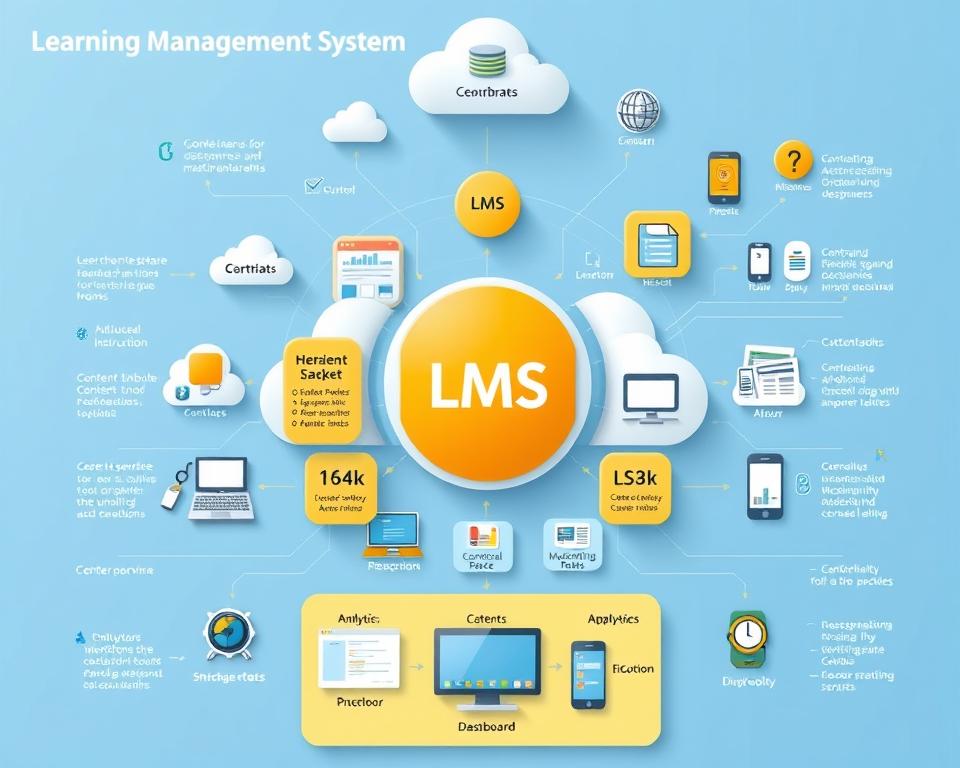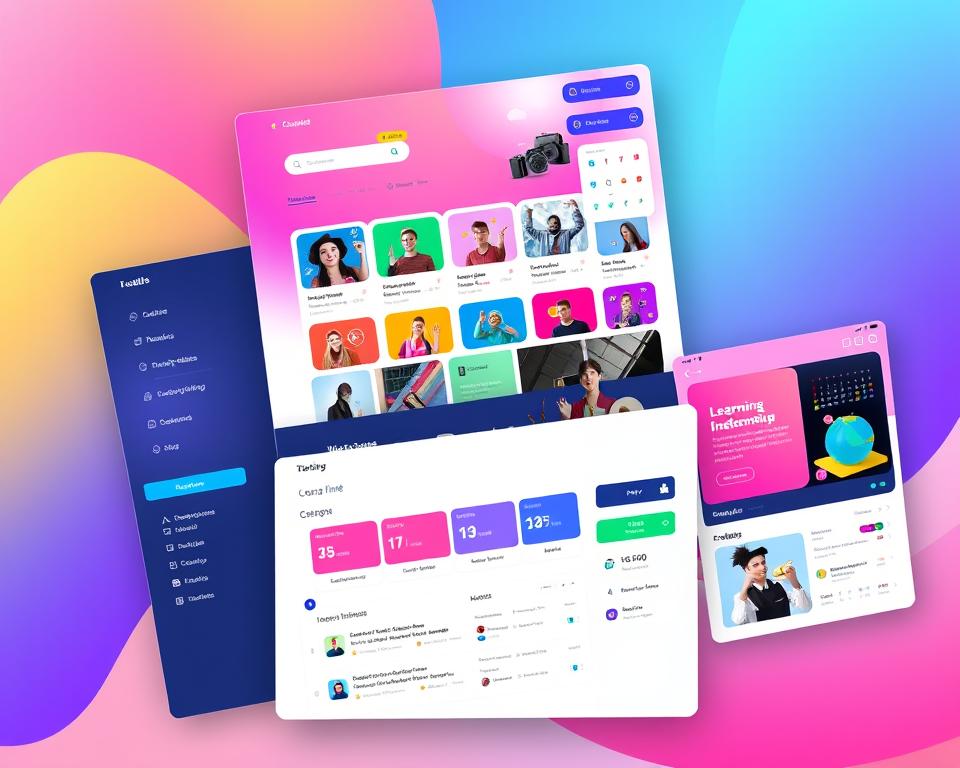In today’s fast-changing digital world, the need for good learning management systems (LMS) is huge. Schools and companies want to improve their learning and training. They need custom LMS apps to help.
These apps make learning easier and offer many tools for a smooth experience. They help deliver educational content well.
E-learning and educational technology are changing how we learn. Schools use new LMS solutions to keep students engaged and track their progress. They also offer personalized learning paths.
Companies see the value of LMS apps in their training programs. They help employees learn new skills, promote ongoing learning, and build a professional development culture.
Table of Contents
Key Takeaways
- Custom-developed LMS apps offer tailored solutions for schools and corporations, addressing their unique educational and training needs.
- LMS platforms streamline the delivery of educational content, track student/employee progress, and facilitate personalized learning experiences.
- The rise of e-learning and educational technology has fueled the demand for innovative LMS applications in both academic and corporate settings.
- Effective LMS development can enhance student engagement, promote continuous learning, and foster a culture of professional development.
- Customized LMS solutions provide schools and businesses with the flexibility to adapt to evolving learning requirements and technological advancements.
Understanding the Fundamentals of LMS Development
Creating a strong LMS architecture and effective e-learning software development is key. It helps build a powerful educational technology infrastructure. Let’s explore the main parts, technical needs, and features of LMS development.
Core Components of Learning Management Systems
An LMS has several key parts that work together. They offer a full learning experience. These parts include:
- User management: This lets users log in securely and manage their roles.
- Content management: It has tools for making, uploading, and organizing course materials.
- Assessment and evaluation: It helps with quizzes, exams, and tracking progress.
- Reporting and analytics: It gives detailed data on how learners are doing and how the system is used.
- Communication and collaboration: It supports discussions, forums, and interactive parts.
Key Technical Requirements for LMS Apps
Building an LMS app needs careful attention to technical details. This ensures a smooth and growing solution. Key needs include:
- A strong database for storing user info, course materials, and test results.
- Flexible tools for creating content that supports different media and interactive parts.
- Secure ways to log in and manage access to protect data.
- Good data syncing and offline options for mobile use.
- A system that can grow with more users and needs.
Essential Features for Educational Platforms
A good LMS meets the needs of learners and teachers. Some important features include:
- Personalized learning paths and content that adapts to learners.
- Elements of gamification to make learning fun and engaging.
- Tools for video meetings and virtual classrooms.
- Tracking of student progress and detailed analytics.
- Easy connection with other tools and systems.
Knowing these basics of LMS development helps organizations build strong learning systems. These systems support both learners and teachers.
Market Analysis: Educational and Corporate LMS Demands
The learning management systems (LMS) market is growing fast. This growth comes from more people using e-learning in schools and businesses. Reports say the global LMS market will hit $30 billion by 2027, with a 23.5% growth rate from 2020 to 2027.
In schools, the need for better learning tools has grown. This is especially true since the COVID-19 pandemic. Schools want LMS that make learning online and in-person easy. They need tools for video calls, managing content, and checking student work.
| Segment | Market Size (2020) | Projected Market Size (2027) | CAGR |
|---|---|---|---|
| Educational LMS | $9.2 billion | $19.8 billion | 21.4% |
| Corporate LMS | $12.4 billion | $26.9 billion | 24.5% |
In the business world, LMS is key for training workers. Companies want tools that let them train anytime. They also need to track how well their training works.
The use of corporate training software is on the rise. This is because businesses want to keep their employees happy and productive. They see the value in e-learning industry growth and how it can help their business thrive.
“The COVID-19 pandemic has made LMS solutions more popular. Companies in many fields see how digital learning can keep their business running smoothly and train their workers well.”
Essential Features for Modern LMS Applications
Today, learning management systems (LMS) need to be strong and flexible. They must have features that meet the needs of schools and companies. Key features include user login, tools for making content, and tracking how learners do.
User Authentication and Role Management
User management is key in any LMS. It should have secure login options for everyone. It also needs to let people have different levels of access based on their role.
Content Creation and Management Tools
Good LMS platforms make it easy to create and manage content. Teachers should have tools to make and share learning materials like videos and quizzes. This makes it easier to keep everything organized and up-to-date.
Assessment and Progress Tracking Features
It’s important to track how well learners are doing. The LMS should have different ways to test learners, like quizzes and surveys. It should also show detailed reports on how learners are doing, helping teachers and managers improve the learning experience.
By having these features, modern LMS platforms can offer a complete learning environment. They support the changing needs of schools and companies. They help learners succeed by focusing on user needs, content creation, and tracking progress.
LMS features, user management, content tools, and analytics are the foundation of a modern, effective LMS.
Selecting the Right Technology Stack for LMS Development
Choosing the right technology stack is key when building a Learning Management System (LMS). The LMS tech stack includes programming languages, frameworks, and tools. The right stack can greatly impact your LMS’s functionality, performance, and upkeep.
Python is a top pick for LMS development. It’s easy to read and use, with a big library of frameworks like Django and Flask. JavaScript is also popular for making the user experience interactive and smooth.
| Technology | Use Case | Benefits |
|---|---|---|
| Python | Backend development, server-side logic | Simplicity, large ecosystem, web frameworks |
| JavaScript | Frontend development, interactive features | Versatility, vast library of frameworks and tools |
| React.js | Building user interfaces | Component-based architecture, efficient rendering |
| Django | Developing LMS web applications | Rapid development, built-in admin interface, ORM |
| MongoDB | Flexible NoSQL database for storing learning content | Scalability, support for unstructured data |
When picking a tech stack for your LMS, think about the project’s complexity and your clients’ needs. Also, consider your team’s skills. By choosing wisely, you can create a strong and scalable LMS that serves your audience well.
Developing Learning Management Systems (LMS) Apps for Schools and Corporations
Creating Learning Management System (LMS) apps for schools and companies is a detailed process. It starts with planning and ends with deployment. This part covers the main steps in making an LMS, the need for thorough testing, and how to deploy it well.
Development Lifecycle Stages
The LMS development journey has key steps like gathering needs, designing, building, integrating, and testing. At the start, the team works with stakeholders to know what the school or company needs. This helps in designing and building the LMS, making sure it fits the audience’s needs.
Testing and Quality Assurance
Testing and making sure the LMS works well is crucial. The team uses a detailed testing plan. This includes checking each part of the app to find and fix problems. This careful testing makes sure the LMS is reliable and easy to use for everyone.
Deployment Strategies
The last step is deploying the LMS. The team works with IT or partners to plan how to roll it out. They consider things like the setup needed, how to get users started, and how to keep the app running smoothly. This careful planning helps the LMS fit smoothly into the school or company’s systems.
| Stage | Key Activities |
|---|---|
| Requirement Gathering | – Understand the specific needs and objectives of the client – Identify the target audience and their requirements – Define the core functionalities and features of the LMS app |
| Design and Development | – Create the user interface and user experience design – Develop the backend infrastructure and integrate with necessary tools – Implement the core LMS features and functionalities |
| Testing and Quality Assurance | – Conduct unit testing, integration testing, and end-to-end testing – Identify and address any technical issues or bugs – Ensure the LMS app meets the required quality standards |
| Deployment and Implementation | – Establish a comprehensive deployment strategy – Collaborate with the IT department or implementation partners – Ensure seamless integration with the existing IT ecosystem |
By following these important steps, schools and companies can make a strong and helpful Learning Management System. This system meets the changing needs of education and business.
UI/UX Design Principles for Educational Platforms
Creating a user-friendly LMS user interface is key for educational success. By using good user experience design principles, developers make educational apps that engage both students and teachers.
It’s important to make the interface easy to use and accessible. This means clear navigation and organized content. It helps improve learning and teaching.
- Implement a clean, uncluttered layout with intuitive menus and actions.
- Leverage visual cues, such as icons and illustrations, to aid comprehension.
- Optimize for mobile devices, providing a seamless experience across platforms.
Also, adding personalization and customization can make the LMS interface better. Letting users adjust the platform to their needs makes them feel more connected and involved.
“Effective user experience design is not just about aesthetics, but about creating an educational environment that empowers learners and instructors to achieve their goals.”
Following these UI/UX design principles helps developers make educational apps that grab users’ attention. It also improves learning results and boosts the success of the LMS user interface.
Integration Capabilities and API Development
The world of learning management systems (LMS) is always changing. Now, it’s key to work well with other tools and share data easily. Good LMS apps need strong integration and API skills to make learning smooth and connected.
Third-party Tool Integration
Great LMS apps should work well with many other tools and apps. This lets teachers and students use their favorite tools. They can work with content authoring tools, video conferencing platforms, assessment engines, and collaboration suites. This makes learning more fun and interactive.
Data Exchange Protocols
LMS apps need to follow standard data sharing rules like xAPI (Experience API) and LTI (Learning Tools Interoperability). These rules help move learner data and course materials smoothly between systems. This makes learning more connected and based on real data.
Security Standards
LMS apps deal with important student and company data. So, they must follow strict security standards. This includes user authentication, data encryption, and access controls. It keeps data safe and follows laws like GDPR and FERPA.
By focusing on LMS integration, API development, data interoperability, and security standards, schools and companies can use LMS apps that really help learning. This makes learning better for everyone.
Mobile-First Development Approach for LMS Apps
In today’s world, mobile devices are everywhere. A mobile-first development approach is key for making effective Learning Management System (LMS) apps. This method puts mobile users first, making sure LMS apps work well on all devices and screen sizes.
Responsive design is a core part of mobile-first design. It makes sure the LMS app looks good and works well on all devices. This means users get a great experience whether they’re using a desktop, tablet, or smartphone. Responsive design uses flexible grids and media queries to make content fit different screens perfectly.
Mobile-first also means thinking about cross-platform development. LMS apps that work on both iOS and Android devices meet the needs of more learners. This makes the LMS more accessible and easier to manage for developers.
By focusing on mobile learning, LMS developers make apps that let users learn anytime, anywhere. This makes learning more flexible and convenient. It can lead to better learning outcomes and a more engaging educational experience for everyone.
| Key Principle | Description | Benefits |
|---|---|---|
| Responsive Design | Adaptable layout and content optimized for various devices | Consistent user experience across desktop, tablet, and mobile |
| Cross-Platform Development | Compatibility with both iOS and Android platforms | Increased accessibility and simplified deployment |
| Mobile Learning | Anytime, anywhere access to learning materials and features | Enhanced engagement, learning outcomes, and educational experience |
By taking a mobile-first approach, LMS providers can make apps that fit right into today’s digital world. This creates a more engaging and accessible learning environment for everyone.
“The future of education is mobile. By designing LMS apps with a mobile-first mindset, we can empower learners to access knowledge and collaborate on-the-go, transforming the way we approach learning in the digital age.”
Data Security and Privacy Compliance in LMS Development
In today’s fast-changing digital world, keeping data privacy and security in learning management systems (LMS) is key. Schools and companies use LMS to share content, manage courses, and track student progress. This makes it crucial to have strong data protection measures and follow important rules.
GDPR and FERPA Compliance
The General Data Protection Regulation (GDPR) and the Family Educational Rights and Privacy Act (FERPA) are major rules for LMS developers. Following these rules is vital to protect students’ educational data protection and handle sensitive info carefully.
Data Protection Measures
- Use strong encryption protocols to keep data safe during transmission and storage
- Set up tight access control to prevent unauthorized access to sensitive info
- Keep an eye on system activities with regular audits and monitoring to catch and stop data breaches
- Create detailed backup and disaster recovery plans to keep data safe
Privacy Policy Implementation
A clear privacy policy is essential for LMS security and data privacy rules. It should explain how user data is collected, used, and protected. It also outlines the rights and duties of both the LMS provider and users.
By focusing on these important data security and privacy compliance areas, LMS developers can create educational platforms that are trustworthy. These platforms protect sensitive info and follow GDPR compliance and FERPA compliance. This ensures a safe and reliable learning experience for everyone.
Scalability and Performance Optimization
As more people use LMS (Learning Management System) apps, making them scalable and fast is key. LMS scalability and performance tuning help handle more users and keep learning smooth.
Load balancing spreads the work across many servers or cloud resources. This stops slowdowns and keeps the LMS fast, even when lots of people are using it. A good load balancing plan makes the LMS more scalable.
Cloud-based LMS solutions have big advantages because of the cloud’s flexibility. Cloud providers can automatically adjust resources as needed. This means the LMS can grow or shrink based on user needs, avoiding waste or not having enough.
Improving LMS performance is crucial. Techniques like caching, database indexing, and code optimization help a lot. They make the server work less, speed up responses, and keep learning smooth, even when lots of people are online.
| Optimization Technique | Benefits |
|---|---|
| Caching | Reduces server load by storing frequently accessed data in memory, improving response times. |
| Database Indexing | Optimizes database queries, enabling faster data retrieval and enhanced performance. |
| Code Optimization | Improves code efficiency, reducing computational overhead and enhancing overall system performance. |
By focusing on LMS scalability and performance optimization, companies can make sure their learning systems grow with their users. This ensures a smooth and fast learning experience for everyone.
Analytics and Reporting Features Implementation
In today’s digital world, schools and companies use learning management systems (LMS) to manage learning. They need strong educational data analytics and reporting tools to get the most out of these systems.
Learning Analytics Integration
Adding learning analytics to LMS is key for tracking student or employee progress. It helps by analyzing data on what they read, their test scores, and how much they learn. This way, LMS reporting tools give insights to teachers and trainers. These insights help them make better learning plans.
Custom Report Generation
- LMS admins can make reports that fit their needs and goals.
- They can track things like who’s attending classes and how skills are growing. This helps see how well learning programs are doing and makes them better.
Performance Metrics Tracking
It’s important to track how well learning programs are doing. LMS should have tools to measure things like who finishes courses, how well they do on tests, and how much they engage. This helps make better choices and keep improving learning.
“The power of data analytics in education lies in its ability to transform how we understand and improve the learning experience.”
With good analytics and reporting, LMS can help teachers, trainers, and leaders make smart choices. This leads to better learning and success for everyone.
Maintenance and Support Strategies
Keeping a Learning Management System (LMS) app running smoothly is key. It’s important for schools and companies to keep their LMS up to date. A good maintenance plan includes regular updates and reliable technical support.
Keeping the LMS Up-to-Date
Regular LMS maintenance is vital. Updates fix bugs, improve security, and add new features. This keeps the LMS current and useful for everyone.
Providing Reliable Technical Support
Good technical support is essential. Users need a team ready to help with any problems. This support ensures the LMS works well with other tools.
Empowering Users Through Training
User training is crucial. It helps everyone use the LMS to its full potential. Training can be in-person, online, or through ongoing support.
| Maintenance and Support Strategies | Description |
|---|---|
| LMS Maintenance | Regular software updates to address bugs, security vulnerabilities, and introduce new features |
| Technical Support | Dedicated team of experts to provide troubleshooting guidance and resolve system issues |
| User Training | Comprehensive training programs to empower users and ensure effective platform utilization |
A solid maintenance and support plan keeps the LMS running well. It makes users happy and helps everyone learn more. This approach is key for success in education and corporate training.
Conclusion
Learning Management Systems (LMS) are key for schools and companies. They help improve education and training. By knowing what makes a good LMS, places can use e-learning to better teach and train.
The need for easy-to-use LMS is growing. These systems must be flexible and use data well. By picking the right tech and following best practices, places can make learning smooth and effective.
The future of LMS looks bright. We’ll see more mobile learning, new tools, and better security. Staying up-to-date with these changes will help places offer the best learning experiences.



















